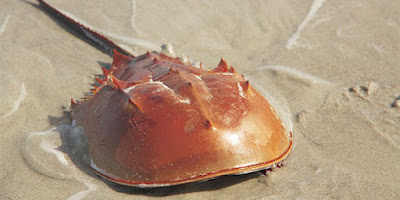#10. Blue Goo
You may have heard oil referred to as liquid gold or about how printer ink is the most valuable liquid in the world (seriously HP, $12,000/gallon for some black goop??? I'm no Marxist, but who wants to seize the means of production with me?). But I bet you didn’t know about this baby blue liquid that’s become indispensable to modern medicine. No, it's not Cool Blue Gatorade. Stay with me for a moment, dear reader, as we take a seemingly unrelated detour through the life of the American Horseshoe Crab.
The horseshoe crab has been around longer than the dinosaurs, outlasting five mass extinctions. Despite its name, it’s not a crab, and it’s a closer relative to spiders than any seafood you’ve seen. With an armored shell and a tail that doubles as a rudder, it looks like a creature from another world. But for millions of years, it’s quietly thrived, feeding on clams and worms in shallow waters, equipped with simple but shockingly efficient biology.
Horseshoe crabs begin their lives on sandy beaches, where thousands of them come ashore each spring in a synchronized spawning spectacle. Females lay clusters of tiny green eggs, often buried just below the surface, and males fertilize them before the tide washes over. Within a few weeks, the eggs hatch, and miniature versions of adult crabs scuttle into the sea. These young crabs will molt and grow repeatedly over the next decade, shedding their shells as they slowly mature. By adulthood, they’re ready to return to the same shores to start the cycle all over again—a process that can continue for up to 20 years if they evade predators and, of course, the grasp of medical researchers.
A medical breakthrough came about in the 1960s when researchers discovered a unique component in horseshoe crab blood called Limulus Amebocyte Lysate (LAL). Unlike human blood, which uses white blood cells to fight infection, horseshoe crab blood clots instantly when it encounters bacterial toxins. This rapid clotting reaction makes it incredibly effective at detecting even trace amounts of contamination. With the discovery of LAL, horseshoe crabs became invaluable to the medical field; their baby blue blood is now used to test everything from IVs to surgical implants to ensure they’re free of harmful bacteria.
In the Atlantic coastal waters of the U.S., hundreds of thousands of horseshoe crabs are collected each year for their life-saving contribution to modern medicine. After being transported to labs, a portion of their blood is extracted—roughly 30%—and then they’re returned to the ocean. Although most survive, the procedure is taxing on the crabs, and a few are lost in the process. For now, despite advances in synthetic alternatives, no substitute fully matches the unique properties of their blood in contamination testing.
During the COVID-19 pandemic, the demand for horseshoe crab blood skyrocketed. In fact, it’s estimated that millions of tests were conducted using Limulus Amebocyte Lysate (LAL) from horseshoe crabs to ensure the safety of vaccine vials. For every batch of vaccines produced, LAL testing was critical to prevent contamination—meaning these ancient creatures played an essential role in protecting millions of lives worldwide. Not bad for an animal that looks like the tip of a boot.


